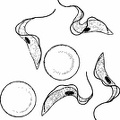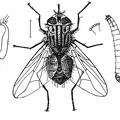When the blood of an infested individual is sucked up and reaches the stomach of such a mosquito, the larvæ, by very active movements, escape from their sheaths and within a very few hours actively migrate to the body cavity of their new host and settle down primarily in the thoracic muscles. There in the course of sixteen to twenty days they undergo a metamorphosis of which the more conspicuous features are the formation of a mouth, an alimentary canal and a trilobed tail. At the same time there is an enormous increase in size, the larvæ which measured .3 mm. in the blood becoming 1.5 mm. in length. This developmental period may be somewhat shortened in some cases and on the other hand may be considerably extended. The controlling factor seems to be the one of temperature.
The transformed larvæ then reenter the body cavity and finally the majority of them reach the interior of the labium. A few enter the legs and antennæ, and the abdomen, but these are wanderers which, it is possible, may likewise ultimately reach the labium, where they await the opportunity to enter their human host.
- Author
- Handbook of Medical Entomology
By William Albert Riley and Oskar Augustus Johanssen
Published in 1915
Available from gutenberg.org - Posted on
- Saturday 16 October 2021
- Dimensions
- 1200*824
- Albums
- Visits
- 566
- Downloads
- 40
 Download Photo
Download Photo





